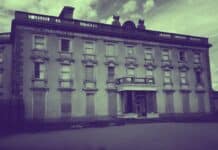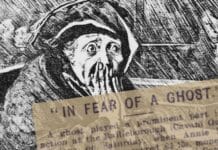Ireland has historically been a land of violence and bloodshed, with much of it hidden behind the oppressive walls of the nation’s institutions. CHRIS RUSH takes a look at the torture and execution methods that went beyond cruel and unusual punishment and made the emerald green landscape run red with the blood of the condemned.
Wicklow Gaol, County Wicklow
Bursting the skin apart via whipping or flogging was a common punishment regime at this location for any misconduct. However other forms of punishment were carried with equal effect.
The treadwheel, developed in 1818, took up residence in the prison in 1820. Inmates where shackled to this device for hours on end and forced to continually step up as the wheel rotated. They were separated into stalls so they couldn’t even talk to one another during the punishment. This device could hold up to 40 individuals at a time. No doubt as the day wore on, the sound of that rotating wheel as the shackles buried themselves deep into the prisoner’s skin would haunt the other prisoners held in overcrowded cells nearby.
The shot drill was a large heavy steel ball, designed to wear down prisoner. An already starving convict was forced to bend their back, not their legs, pick up the ball and hold it at chest height for a number of seconds. They would then either place it back down to its original position and repeat or pass it to another prisoner who’d have to perform the same action and then hand it back. This task also had to be carried out in complete silence!! If any sounds of exertion or pain were heard the prisoner’s rations were taken away from them.
Cork Asylum, Cork City
Stone floor cells, minimal heating, overcrowding and a high fever rate occurred within these walls. The dead would be left to rot on the floor for days in the company of the living, and patients had manacles attached to their ankles so they could be restrained to a bed for various experiments.
A favourite treatment of this asylum was the circulating chair. Carried out by Dr. William Hallaran, a patient would be strapped roughly into this device, either sitting upright or laying down and then rotated at a very high speed, possibly 60 times per minute. In 1810, Hallaran outlined that the treatment was used as a form of obedience assurance and in the depressed it was used to provoke “A natural interest in the affairs of life.” One can assume that many a patient’s stomach contents were flown about that room and little success came from the method.
Kilkenny Gaol, Kilkenny
Petronella De Meath was servant to renowned innkeeper and businesswoman Alice Kyteler, who was charged with witchcraft and the murder of her husband by poisoning in 1324 and was the first ever case of witchcraft tried in Ireland. by the time the trial had begun, Alice has absconded to England leaving behind Petronella to face the court. Petronella herself was accused as heading the witches’ coven and was viciously whipped through several parishes until she finally broke. While delirious with pain and festering wounds, under the guidance of the perversity of the Bishop, Petronella confessed to charges of witchcraft and conspiring with demons – one of which was named Robin, Son of Art. To get demonic attention she said she and other witches had completed sacrifices and created magic candles and ointments under demonic instruction using “the entrails of cocks sacrificed to demons, certain horrible worms, various unspecified herbs, dead men’s nails, the hair, brains, and shreds of the cerements of boys who were buried unbaptized, with other abominations, all of which they cooked, with various incantations, over a fire of oak-logs in a vessel made out of the skull of a decapitated thief.” This was enough to convict her and after another round of torture in public, she was burnt alive in Kilkenny on third day of November 1324 – the first occurrence in Irish history where someone was executed for heresy.
Mountjoy’s Hanghouse, Mountjoy Prison, Dublin
Between them, Tom and Albert Pierrepoint executed 29 people on behalf of the Irish State, Albert doing the majority of them. He would light a cigar and leave it to one side while he carried out his work and then collect it once the task was complete. The hangings were carried out at 8am in Mountjoy and the limp body would be left hanging for an hour to ensure the strangulation was complete. The Pierrepoint men were paid £10 and expenses for their efforts and afterwards the governor would rate their hanging performance.
Kilmainham Gaol, Dublin
In March of 1786, Robert Jameson was hung and gibbeted. This was a practise which involved placing the snap-necked, naked body into a bath of boiling pitch or tar. Once cool, the human statue-like remains were placed into a cage which was then hoisted into the air. Robert’s body was displayed using a tall wooden support. This type of execution was used to deter any other individual from carrying out the same crime, the corpse would be left open to the elements until it rotted away or was eaten by the birds. After a week Robert’s body was chopped down outside Kilmainham Jail, it was rehung and displayed once more by the jail only for it to be taken down two weeks later again. Following this the Robert’s body was removed from the iron cage and buried on Gallows Hill.
Ireland is a land commonly known as the “Home of a Thousand Welcomes.” However, one may also wonder is it the home of a thousand torture methods.









